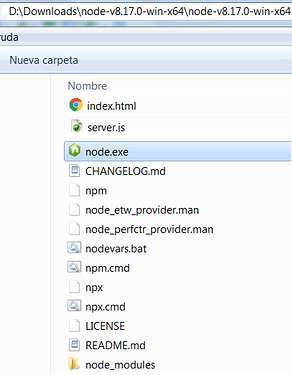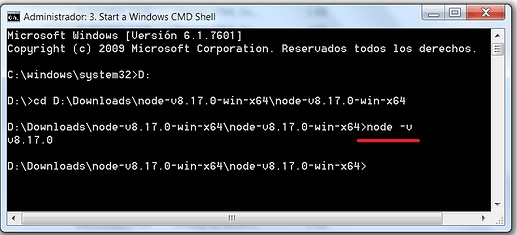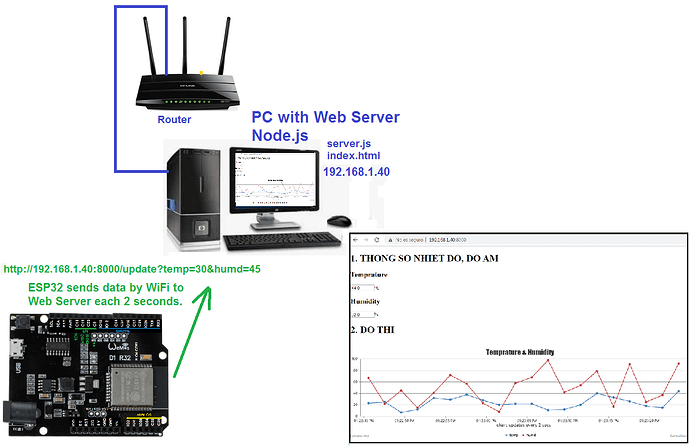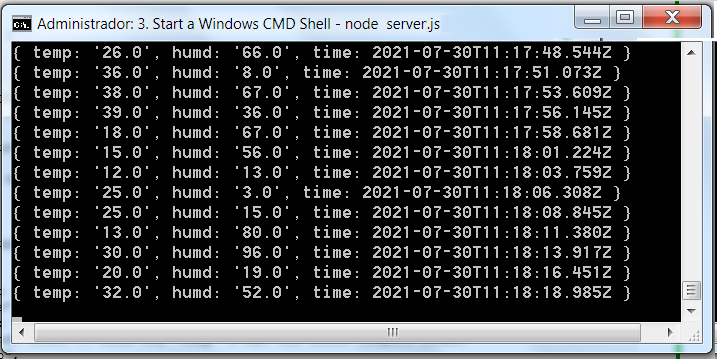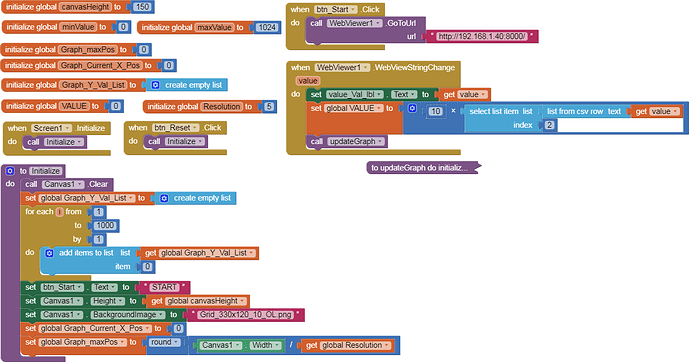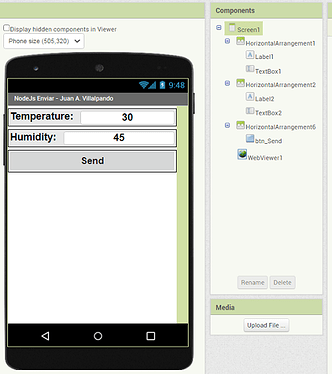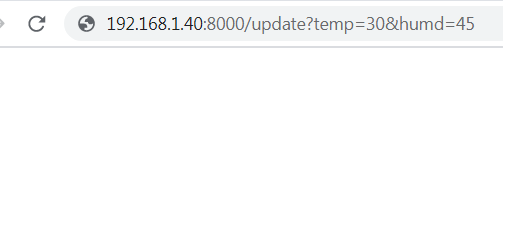Hello friends, here I share my experience with Node.js in Windows 7.
Node.js is mainly used to create a Web Server on a PC.
Node.js is open-source, cross-platform, JavaScript, Web server, dynamic web page, real-time Web applications,...
In this topic I will write about creating a Web Server in Windows. Communicate ESP32/ESP8266 client with that Server. Send/receive information from Android to ESP32/ESP8266,.... Run batch files from Android to Windows ...
oooooooooooooooooooooooooooooooooooooooooooooooooooooooooooo
1.- Install in Windows. "Portable".
I tried to install the latest version of Node.js on my Windows 7...
...but it did not allow it.
-
So I downloaded an older version of: https://nodejs.org/dist/latest-v8.x/
-
This version: node-v8.17.0-win-x64.zip
-
I unzipped it and used it as "Portable". (about 55 MB)
-
Windows CMD Shell,
Write node -v
1 Like
2.- Create a Web Server in PC with Node.js
Create a file called server.js in the node folder with this content:
var http = require("http");
function onRequest(request, response) {
console.log("Received client.");
response.writeHead(200, {"Content-Type": "text/html"});
response.write("Hola Mundo.");
response.end();
}
http.createServer(onRequest).listen(8888);
console.log("Server started.");
./node.exe server.js
3.- ESP32 client sends temp,humd each 2 seconds to Web Server Node.js. Show graphic in a web page in real-time.
- ESP32 working as a client, will send temperature and humidity values to the Node.js Server every 2 seconds, in my case with IP 192.168.1.40
http ://192.168.1.40:8000/update?temp=30&humd=45
-
The server will display the information in real time in a graph using the page index.html
-
In the tutorial, copy the server.js and index.html files to the node folder.
-
Load the code into the ESP8266 or ESP32.
-
My changes:
-
In ESP code I have changed this line to work in ESP32:
// #include <ESP8266WiFi.h> // ESP8266
#include <WiFi.h> // ESP32
- In the ESP code I have changed these lines so that the temperature and humidity values are created randomly, for testing.
float temp = dht.readTemperature();
float humi = dht.readHumidity();
temp = random(0,50); // RANDOM
humi = random(0,100); // RANDOM
4.- ESP32 client sends data each 2 seconds to Web server, Android receives data by WebView component. Show in dynamic graphic.
- This will be a new index.html file:
- Look: window.AppInventor.setWebViewString("" + temp_humi);
<!DOCTYPE html>
<html><head> <meta charset="UTF-8"><title>DHT11</title></head>
<body>
<script type="text/javascript">
function httpGetAsync(theUrl, callback) {
var xmlHttp = new XMLHttpRequest();
xmlHttp.onreadystatechange = function() {
if (xmlHttp.readyState == 4 && xmlHttp.status == 200)
callback(JSON.parse(xmlHttp.responseText));
}
xmlHttp.open("GET", theUrl, true); // true for asynchronous
xmlHttp.send(null);
}
window.onload = function() {
var updateInterval = 2000;
var time = new Date();
var update = function() {
httpGetAsync('/get', function(data) {
var temp_humi = data[0].temp + "," + data[0].humd;
window.AppInventor.setWebViewString("" + temp_humi);
time.setTime(time.getTime() + updateInterval);
});
};
update();
setInterval(function() {
update()
}, updateInterval);
}
</script>
</body>
</html>
- App Inventor.
p9A0i_esp32_nodejs.aia (7.4 KB)
- Note that it does not use a Clock, the values are received automatically.
5.- Android with WebView component sends data to Server Node.js, ESP32 receives those values and shows in Serial Monitor.
p9A0i_esp32_nodejs_Envia.aia (2.1 KB)
- We write temperature and humidity, and Click the button.
- WebViewer sends values to server:

// Juan A. Villalpando
// http://kio4.com/arduino/117_Wemos_NodeJs.htm
// #include <ESP8266WiFi.h>
#include <WiFi.h>
#include <ArduinoJson.h>
const char* ssid = "Nombre_Red_Wifi";
const char* password = "Clave_Wifi";
const char* host = "192.168.1.40";
void setup(){
Serial.begin(115200);
delay(10);
// Conecta a la red wifi.
Serial.print("Conectando con ");
Serial.println(ssid);
WiFi.begin(ssid, password);
while (WiFi.status() != WL_CONNECTED) {
delay(500);
Serial.print(".");
}
Serial.println("Conectado con WiFi.");
// Esta es tu IP
Serial.print("Tu IP: ");
Serial.print(WiFi.localIP());
}
void loop(){
Serial.print("Conectando con ");
Serial.println(host);
// Cliente
WiFiClient client;
const int httpPort = 8000;
if (!client.connect(host, httpPort)) {
Serial.println("Fallo en la conexión.");
return;
}
// Linea de petición
String url = "/get";
Serial.println(url);
// Esto es lo que se enviará al servidor.
client.print(String("GET ") + url + " HTTP/1.1\r\n" +
"Host: " + host + "\r\n" +
"Connection: close\r\n\r\n");
unsigned long timeout = millis();
while (client.available() == 0) {
if (millis() - timeout > 5000) {
Serial.println(">>> Rebasado 5 segundos.");
client.stop();
return;
}
}
// Lee todas las líneas que ha enviado el servidor.
while(client.available()) {
String lineas = client.readStringUntil('\r');
if (lineas.indexOf("[{") != -1) { // Linea que contiene [{.
Serial.println(lineas);
String json = lineas.substring(2,lineas.length()-1); // Elimina [ ]
Serial.println(json);
StaticJsonBuffer<200> jsonBuffer;
JsonObject& deco = jsonBuffer.parseObject(json);
if(!deco.success()) {Serial.println("parseObject() failed");}
else { String temp = deco["temp"];
String humd = deco["humd"];
String tempo = deco["time"];
Serial.println(temp);
Serial.println(humd);
Serial.println(tempo);
}
}
}
Serial.println("Conexión cerrada.");
}
6.- Save data in a file.
- We modify the code of the server.js file.
//-----------------------------------------------------------------------------------------
if (pathname == '/update') {
var newData = {
temp: queryData.temp,
humd: queryData.humd,
time: new Date()
};
db.push(newData);
console.log(newData);
response.end();
fs.appendFile('datos.txt', JSON.stringify(newData) + '\n', function (err) {
if (err) return console.log(err);
console.log('Save in datos.txt');
});
//-----------------------------------------------------------------------------------------
7.- Android sends data to Server. Server performs a calculation and returns the result to Android. Pythagoras theorem.
p9A0i_esp32_nodejs_pitagoras.aia (2.8 KB)
datos = window.AppInventor.getWebViewString(); // INPUT
Calculate.
window.AppInventor.setWebViewString("" + hipotenusa); // OUTPUT
- Now copy this file: pitagoras.htm in Web server, in node folder:
<!DOCTYPE html>
<html>
<head><meta charset="utf-8"></head><body>
<script>
datos = window.AppInventor.getWebViewString(); // Entrada de datos.
datos = datos + ":";
catetos = datos.split(":");
cateto1 = catetos[0];
cateto2 = catetos[1];
hipotenusa = Math.sqrt(Math.pow(cateto1, 2) + Math.pow(cateto2, 2)) ;
window.AppInventor.setWebViewString("" + hipotenusa); // Respuesta a CadenaDeWebView
</script>
</body></html>
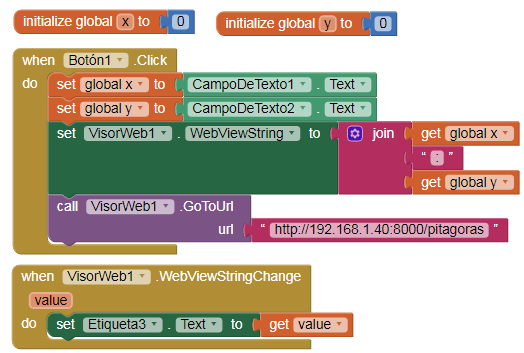
//-----------------------------------------------------------------------------------------
} else if (pathname == '/pitagoras') {
fs.readFile('./pitagoras.htm', function(error, content) {
response.writeHead(200, {
'Content-Type': 'text/html'
});
response.end(content);
});
//-----------------------------------------------------------------------------------------
8.- Android sends an order to Node.js to run a batch file, this batch file shutdown PC.
- This batch file apagar.bat shutdown PC.
apagar.bat
shutdown /s /f /t 30
- Change in server.js file:
//-----------------------------------------------------------------------------------------
} else if (pathname == '/apaga') {
const { exec, spawn } = require('child_process');
exec('apagar.bat, (err, stdout, stderr) => {
if (err) {
console.error(err);
return;
}
console.log(stdout);
});
//-----------------------------------------------------------------------------------------
- When receives pathname == '/apaga', exec apagar.bat
- App Inventor.

- To cancel shutdown, write in CMD Shell
shutdown -a
OOOOOOOOOOOOOOOOOOOOOOOOOOOOOOOOOOOOOOOO
- You can create other batch files, for example a batch file with notepad.exe, it will run the Notepad.
9.- Install Node.js in Android with Termux.
-
Termux is a shell.
-
Install app Termux in your Android (Termux is in Play Store).
-
pkg install nodejs-lts
-
home: /data/data/com.termux/files/home
-
node command in: /data/data/com.termux/files/usr/bin
-
I have only installed it but have not used it.
